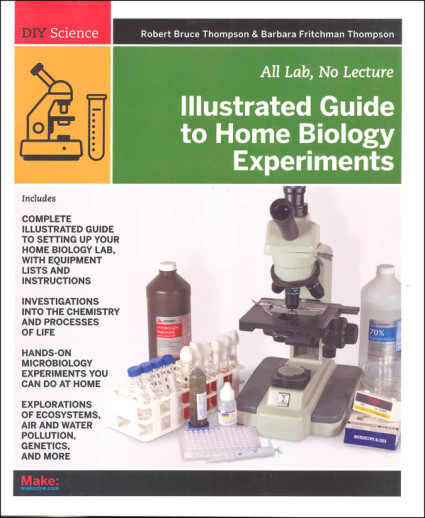We use cookies to make your experience better. To comply with the new e-Privacy directive, we need to ask for your consent to set the cookies. Learn more.
Illustrated Guide to Home Biology Experiments
Subtitled, "All Lab, No Lecture and this book delivers! Truly a DIY Science book, you will find this a valuable resource with a completely illustrated guide to setting up a home biology lab without expensive lab equipment (high school quality microscope required), as well as an easy to use lab manual for a rigorous first-year high school biology course. Beginning with an overview of how to use the book, set up a home biology lab (including how to choose a microscope) and lab safety, the book dives into 30 lab sessions that incorporate nearly 80 separate procedures! Following each procedure are review questions that require students to analyze the activities using the scientific process.
Topically, students will learn how to master the microscope and build and observe a microcosm. They will also explore the chemistry of life: acids, bases, and buffers, carbohydrates and lipids, proteins, enzymes and vitamins; life processes (plants); ecology; genetics; cells and unicellular organisms, including protista, fungi, plants and animals (worms). Each lab procedure begins with a list of equipment and materials used. While many of these are easy to find, there are some specialized items you will need available to begin: goggles, forceps, gloves, book light or lamp, various prepared slides (call for list); cover slips; glycerol; pipettes; scalpel, well and flat slides; methylene blue; butane lighter (flame source); microtome (instructions included to make your own); eosin Y; Gram's Iodine; Hucker's crystal violet; 70% ethanol; methylcellulose; pH paper; particulate mask; centrifuge tubes (15 and 50 ml); fertilizer concentrate; hydrochloric acid; lead (II) acetate; acetic acid; Beakers (10, 100 and 250 ml); graduated cylinder; 24 and 96 well reaction plate; sodium hydroxide solution; Barfoed's reagent; Benedict's reagent; dextrose; Seliwanoff's reagent; test tubes/test tube rack and test tube clamp; Sudan III stain; Ascorbic Acid tablet; sodium hydroxide; thermometer; sodium dodecyl sulfate; alligator clip leads; agar; Safranin O stain; chromatography paper; bromothymol blue; Ammonium Nitrate; Nitrogen Free Fertilizer (concentrate A-B-C) inoculating loop; rhizobia inoculum; vermiculite; balance; Sodium Borate solution; PTC test strips; Amoxicillin antibiotic cap; Antibiotic powders (chlortetracycline, neomycin and sulfadimethoxine); and teasing needles. But don't let the specialized equipment scare you from this great resource! The authors' website The Home Scientist offers a standard kit containing these items (with the exception of commonly found items, the balance and the prepared slides). This website also includes links to recommended secular, online Biology textbooks, as well as a syllabus aligned to the 2nd ed. Apologia Biology text and the BJU 4th ed. Biology textbook, which makes this a worthwhile option for obtaining high school Biology with Lab credit on your child's high school transcript. This would also make an excellent resource to use alongside the Holt Biology course, or to add a lab science credit to a Charlotte Mason/Living Book Science experience. Detailed index adds to the ease of use for creating your own Biology lab at home. 358 pgs, sc. ~ Deanne
This hands-on introduction includes dozens of educational (and fun) biology experiments that let readers explore this fascinating field on their own. Perfect for middle- and high-school students and DIY enthusiasts, this full-color guide teaches readers the basics of biology lab work and shows them how to set up a safe lab at home.
| Product Format: | Paperback |
|---|---|
| Brand: | Maker Media |
| Author: | Robert Bruce Thompson |
| Grades: | 4-AD |
| ISBN: | 9781449396596 |
| Length in Inches: | 9.75 |
| Width in Inches: | 8 |
| Height in Inches: | 0.8125 |
| Weight in Pounds: | 1.7 |

